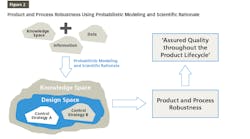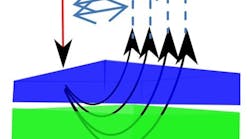Many in the industry are likely aware of the hurdles in going from QbA (quality by analysis) to QbD (quality by design)[1]. In 2009, I wrote an article in Pharmaceutical Manufacturing discussing the other letters associated with the effort, the “B” for bureaucracy and the “C” for consternation. Unfortunately, these two obstacles are definitely still in play, not to mention the prevailing culture and perceived lack of financial justification. There are methods that can be used to overcome these obstacles, but I refrained from expounding on them at that time. Rather, I focused on how better manufacturing technologies should be considered and incorporated to get to “D” rather than what else can assist to get there.
I still believe improved technologies and better quality product will yield higher profits for companies and lower the price of drugs for pharma’s patient base. In addition, with better technologies Pharma will exceed regulations rather than follow them.
With pharmaceutical’s changing landscape and major percentage of drugs becoming generic and being supplied by companies from the developing countries (global manufacturing), supply chain and distribution have become more complex. Regulatory bodies are challenged to access manufacturing practices and product quality. Pharma companies that will become proactive and implement better technologies to produce quality products will reap extraordinary benefits; unless the change is internalized, not much will happen.
The pharmaceutical industry does want to get to “D” of the QbD and understands its benefits. Even the regulators through their various directives and guidances are cajoling the industry move from A to D by using better manufacturing technologies. All said and done, financial justification is still needed, especially for the existing products. Some may consider justification to be a stringent challenge and cannot be met.
Since Pharma’s profits are assured with the current methods in the prevailing model, it has not been able to justify use of better technologies to achieve “quality by design.” Many could say this is not true. But if it was not true, the global regulatory bodies and the industry would not be talking about “quality by design.” QbD would have been an industry norm about 50-plus years ago.
There are other ways to justify getting to “D.” They have been in front of us all along but have been overlooked. If we took a second look, it would show us opportunities to justify moving from QbA to QbD. Since investment decisions are made on “financial return,” management has to have necessary rationale to make value decisions. Implementation of approved projects has to be a collective company responsibility. A desire to excel has to be instilled and impressed across every level in the company trickling down from every “C and S” level.
COST REVIEWS
Finance departments can take the lead and evaluate the existing practices. They can select a single product, and besides developing generally accepted standard costs, they can run a parallel cost review using “activity based costing” [2,3,4]. Pharma can also use “zero-based budgeting” [5,6,7] to review financial contribution of each process step — especially R&D, quality control, inventory management, engineering and other non-manufacturing related activities.
Cost reviews are not a new concept and have always led to better technologies and process steps in every business. ABC and ZBB have been used in the past and have benefited companies [8]. They were in style some years ago, but like fashion, they disappeared. Fashion repeats itself every so often; maybe it is time to use these methods in the pharmaceutical industry. These methods may be out of the comfort zone for many, but unless we are challenged, we seldom excel. The question for Pharma has to be: “does it want to be the technology and quality leader or be led by the regulations?” Regulatory lead has taken the industry nowhere.
An ABC- and ZBB-based analysis using different “what if “ scenarios will show the opportunities in R&D, process development, manufacturing and many steps of the total business. These could include impact of how new products are developed, process development/commercialization, yield improvement, asset utilization, operating time, higher inventory turns (raw material, work in-process, finished goods, etc.) and value of higher production volumes. Other factors that suit a company could be included in the analysis.
These analyses when used in Pharma will definitely show shortfalls due to low inventory turns, current production volumes, low process yields for APIs and formulations, cycle time variation in APIs and their formulations, as well as extraordinary efforts needed in quality control and asset utilization and their management. R&D development process would show its weaknesses.
Information developed will show significant opportunities in revenue and profitability improvement when benchmarked against the current practices. It is my conjecture that the analysis will point to the need for better manufacturing technologies and would necessitate higher production volumes. These analyses will also show that a different model is needed for generic Pharma.
ABC and ZBB “what if” analysis/modeling could be based on any or all of the following statements:
• Financial impact of improved inventory turns for the raw materials, work in process and finished goods inventories
• Cost impact of higher process yields
• Impact of better manufacturing technologies than the prevailing technologies
• Impact on costs of higher volume of API or/and their formulations
• Impact of lower effort needed to check for product quality due to better manufacturing technologies that will produce higher quality product
• Impact of improved R&D on the overall development and commercialization of products
Through ABC and ZBB analysis, companies can justify spending monies on technologies that will improve inventory turns and product yields, reduce regulatory oversight and significantly lower time to produce quality products, thereby increasing company profits and lower the selling price of the drugs by 20-25 percent, which would make drugs affordable to many additional patients. That would be a global win for the pharmaceutical industry and patients.
REFERENCES
[1] Malhotra, Girish: Alphabet Shuffle - Moving From QbA to QbD, Pharmaceutical Processing, March 2009, pgs 12-13
[2] Activity Based Costing, http://en.wikipedia.org/wiki/Activity-based_costing accessed March 27, 2015
[3] Katz, David M.: Activity-Based Costing, http://ww2.cfo.com/2002/12/activity-based-costing-abc/ December 31, 2002 accessed April 6, 2015
[4] Cooper, Robin; Bray, David; Parzen; Who Wins in a Dynamic World: Theory of Constraints Vs. Activity-Based Costing, http://papers.ssrn.com/sol3/papers.cfm?abstract_id=962270, North American Assoc. for Computational Social and Organizational Science (NAACSOS) Conference, June 2007 accessed April 6, 2015
[5] Phyrr, Peter A.: Zero-Base Budgeting, Harvard Business Review, November-December 1970, pp. 111-121
[6] Zero Based Budgeting, http://en.wikipedia.org/wiki/Zero-based_budgeting accessed April 6, 2015
[7] Lin, Thomas, W: Zero-Base Budgeting: An Analysis, http://raw.rutgers.edu/MiklosVasarhelyi/Resume%20Articles/OTHER%20PUBLICATIONS/L12.%20zero%20base%20budgeting.pdf accessed March 27, 2015
[8] Interview with Mr. Sam Samdani, McKinsey & Co., April 6, 2015




